- EEE8089 Assignment: Raspberry Pi Network Architecture and Remote Access Configuration
- ILM Unit-409: focused on understanding the impact of development on workplace performance: Managing Personal Development, Coursework, UOS, UK
- ILM Unit-409: focused on implementing and evaluating planned development activities and apply learning in the workplace: Managing Personal Development, Coursework, UOS, UK
- ILM Unit-409: focused on identifying and prioritising work-related development requirements: Managing Personal Development, CourseWork, UOS, UK
- 7PS032: Identify type of study design needed, including within or between groups where relevant: Research Methods Course Work, UOW, UK
- 7PS032: What do the means, range and standard deviations show?: Research Methods Course Work, UOW, UK
- 7PS032: You need to write a research proposal. It must be a quantitative research proposal: Research Methods Course Work, UOW, UK
- MN0493: Report the major points of your discussions with the client. This should include the construction of the portfolios: Investments and Risk Management Course Work, NUN, UK
- DAT7303: In portfolio 3, students must complete 4 tasks related to analysing a dataset using CRISP- DM methodology: Data Mining Course Work, UK
- BUSI 1475: Your task is to identify and select an article from the BBC News website (news.bbc.co.uk): Management in a Critical Context Course Work, UOG, UK
- COMP6029: Computer Science and Electronic Engineering related subjects generally use the IEEE referencing style: Network Systems Course Work, UOS, UK
- UMACTF-15-M: You have recently been appointed as a Financial Analyst for a leading investment bank in London: Corporate Financial Strategy Course Work, UWE, UK
- BAM5010: choose an organisation and make some recommendations for the delivery: Work Based Project Course Work, UOB, UK
- You are required to calculate ratios for Fresh Farms Ltd: financial Course Work, UK
- Understand the legal, ethical and theoretical context for health, safety and risk management: leadership and Management Course Work, UK
- P3 Describe the types of training and development used by a selected business: BTEC Business Extended Diploma Pearson Course Work, UK
- Describe how a selected business identifies training needs: BTEC Business Extended Diploma Pearson Course Work, UK
- Discuss your chosen business, background information and why you have chosen that business: BTEC Business Extended Diploma Pearson Course Work, UK
- Activity 7: Risk management in an organisation should be both sensible and proportionate to the level of risk involved: NEBOSH IDIP ID1 Research Paper Course Work, OU, UK
- Activity 6: Reviewing health and safety performance Critique your chosen organisation’s health and safety: NEBOSH IDIP ID1 Research Paper Course Work, OU, UK
Figure 1 shows a tower crane with the properties listed in Table 1. The distance between the trolley and mast: Statics and Dynamics Course Work, NUN, UK
| University | Northumbria University Newcastle (NUN) |
| Subject | Statics and Dynamics |
Question 1
Figure 1 shows a tower crane with the properties listed in Table 1. The distance between the trolley and mast x can change from 0 to dj (Figures 1 and 2).
Table 1: Specifications of the tower crane
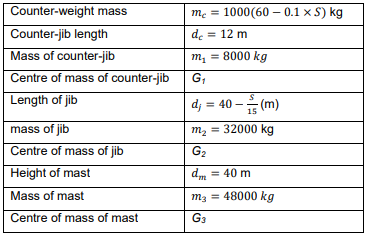
- Draw the free body diagram of the tower crane and calculate the reactions at O when the mass of the lifted body 𝑚 = 5000 𝑘𝑔 and the distance 𝑥 = 20 m
- When 𝑚 = 5000 kg, find and plot the moment at O as a function of 𝑥, and determine the value of 𝑥 when the moment at O is zero
- If the magnitude of the maximum moment at O is 2,500 kN∙m and the magnitude of the maximum force at O is 1,650 KN, calculate the maximum mass of the body that the tower crane can lift regardless of the trolley location.
- When lifting heavy bodies with two points is required, a spreader beam is used (Figure 3). If 𝑤₁ = 0.7 m, 𝑤₂ = 1.4 m, 𝑚 = 1000 × (5 − 0.010 × 𝑆) 𝑘𝑔, and the mass of the spreader is negligible:
1. Calculate the tension forces in the slings AB and CD when the lifted body is not tilted
2. To prevent the body from tilting, what should be considered in the design and operation of the spreader beam?
Buy Answer of This Assessment & Raise Your Grades
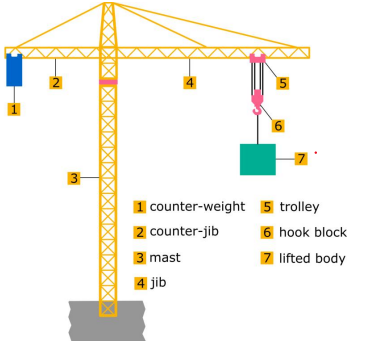
Figure 1: its model
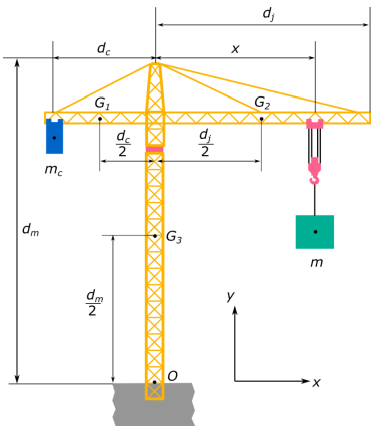
Figure 2: Tower crane specifications
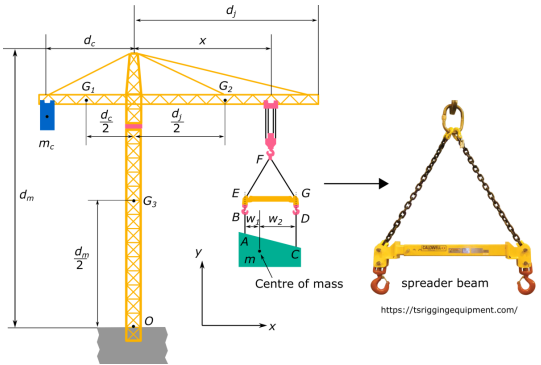
Question 2
The car acceleration time history for 62 seconds (i.e., between 2:42:27 pm and 2:43:29 pm) is shown in figure 4. During this time, the car accelerates from 36 mph (Miles per hour) to 200 mph and then decelerated to 24 mph. your tasks for this question are,
- Calculate the velocity at time 𝑡₁ and 𝑡₂ in m/s, km/h, and mph. Individual 𝑡₁ and 𝑡₂ are provided for each student in the attached file
- Bring evidence from the video to show the accuracy of your calculation. For example, the calculated velocity at 𝑡 = 62 (𝑠) is 29.3 mph. The actual velocity based on the following figure is 24 which is close to the calculated velocity
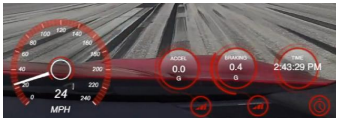
- Compare your calculated velocities with the actual velocities of the car and calculate their differences in percent.
- Explain the reasons for discrepancies between calculated and actual velocities.
Do You Need Assignment of This Question
Are you struggling with your Statics and Dynamics coursework? Look no further! At Diploma Assignment Help UK, we offer comprehensive assistance for your coursework needs. Our team of experts is well-versed in this subject and can help you excel in your assignments. From analyzing complex data to understanding the principles of motion, we’ve got you covered. Get top-quality guidance and support at affordable prices.



